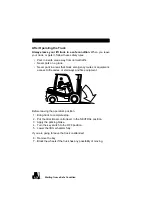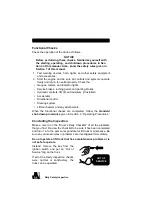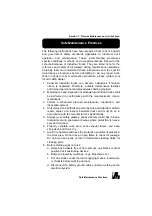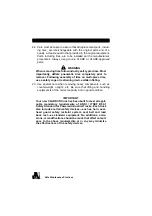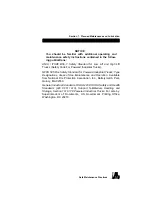
6-2
How to Tow a Disabled Truck
How to Tow a Disabled Truck
If your lift truck becomes disabled but it can be moved freely on its
own wheels without further damage, use the following procedures to
tow it safely to a repair area.
IMPORTANT
It is important for your safety and the care of your lift truck
to use the proper equipment and carefully follow these
recommendations for safe towing.
WARNING
!
DO NOT tow a lift truck if there is a problem with the brakes
or tires or the steering cannot be operated. DO NOT tow up
or down ramps and steep inclines. DO NOT attempt to tow
a lift truck if traction or weather conditions are poor.
1. Be sure to apply the parking brake or block the drive wheels on
the disabled truck while working around it.
2. When possible, raise the carriage (forks) on the disabled truck
about 12 inches (300 mm) from the floor or ground. Secure the
carriage with a chain.
3. Obtain another lift truck of equal or larger size carrying a partial
load for traction.
4. Check that the counterweight bolts are in place and properly
torqued. (This bolt is made of a special high-tensile steel and is
not commercially available. Replace it, when necessary, only with
a genuine Clark replacement part).
5. Use an approved, solid metal tow bar with towing couplers that
connect to the towing pins in the counterweights.
6. Release the parking brake on the towed vehicle.
7. Transmission control is in neutral.
NOTICE
DOT approved towing equipment may be available from
your Clark dealer.
8. Tow the disabled truck backward.
An operator must be on the
towed truck
. Tow the truck slowly. Careful towing is necessary
to prevent injury to personnel or damage to the truck. The truck
should be towed at a speed of less than 5 m.p.h. (8 kph) with a
driver in the seat. Do not lift the truck or any wheels off the floor
or ground while the truck is being towed.
Summary of Contents for C15 D
Page 2: ......
Page 6: ...iv...
Page 16: ...1 4 Seat Belts Seat Belts ALWAYS BUCKLE UP Seat belts can reduce injuries...
Page 30: ......
Page 88: ...5 8...
Page 107: ...PM Report Form 7 13 Section 7 Planned Maintenance and Lubrication...
Page 124: ...7 30...
Page 142: ......
Page 143: ......





